KENDO
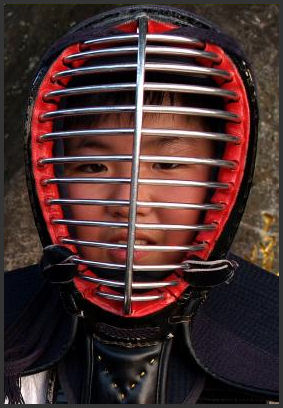
Kendo Kid Kendo is the Japanese version of sword fighting between combatants called kendoka. Each kendoka wears a black padded robe and metal masks and battles his opponent with a two-handed wooden stave. Kendo means "sword way." It is based on sword fighting techniques used by samurai warriors.
Among the “samurai”, the sword was one of the most important of martial arts. Perhaps because of this tradition, “kendo “(Japanese stick fencing) places strong emphasis on ritualized behavior in the “dojo”, and practice sessions tend to be highly regimented. With the establishment of the All Japan Kendo Federation, in 1952, “kendo “was revived as a sport and was introduced into the curricula of junior high and high schools. [Source: Web-Japan, Ministry of Foreign Affairs, Japan]
The concepts behind kendo date back to feudal times, when samurai would wait for their opponents to attack before making their move. Most blows are delivered with two hands of the wooden stave, which is regarded as wooden imitation of real sword. “Katana Iadido” (the art of drawing a real sword) and “nagintado” ( a martial art which uses a weapon similar to a halberd) are linked with kendo.
Kendo was developed as a form or mental training more than physical exercise but now is regarded a sport that emphasizes winning. It has many old customs associated with it. When you put on the uniform for example, you are supposed to start by placing you left leg in the trousers first. Kendo is best done on a springy wood floor.
Good Websites and Sources: Kendo: All Japan Kendo Federation, All Japan Kendo Federation ;International Shinkendo Federation shinkendo.com ; International Kendo Federation kendo-fik.org ; Wikipedia article on Kendo Wikipedia ; Kendo World kendo-world.com Photos at Japan-Photo Archive japan-photo.de ; Wikipedia article on Japanese Martial Arts Wikipedia ; Japanese Martial Arts allmartialarts.com ; Classical Martial Arts Resource koryu.com
Kyudo (Japanese Archery) : Photos at Japan-Photo Archive japan-photo.de ; Photos of Horseback Archery at Japan-Photo Archive japan-photo.de ; Meishin Kyudojo kyudo.com ; Archery from Clan Yama Kaminari yamakaminari.com ; Kyudo.com kyudo.com ; All Nippon Kyudo Federation kyudo.jp ; White Rose Kyudojo japanese-archery.org.uk ; Weapon-Based Martial Arts Shinkageryu, a martial with swords shinkageryu.us ; Dragon Hoshi Defense dragonhoshidefense.com ; Naginata konishi.co.jp ; Classical Martial Arts Resoruce koryu.com
Links in this Website: SPORTS IN JAPAN (Click Sports, Recreation, Pets ) Factsanddetails.com/Japan ; SUMO RULES AND BASICS Factsanddetails.com/Japan ; SUMO Factsanddetails.com/Japan ; KARATE, AIKIDO AND JAPANESE MARTIAL ARTS Factsanddetails.com/Japan ; JUDO, JAPAN AND THE OLYMPICS Factsanddetails.com/Japan ; KENDO, ARCHERY AND JAPANESE MARTIAL ARTS WITH WEAPONS Factsanddetails.com/Japan ; BOXING AND PRO WRESTLING IN JAPAN Factsanddetails.com/Japan
History of Kendo
Kendo grew out of “kenjutsu” ("swordsmanship"), a method of sword training used by samurai in feudal Japan that, according to Japan's oldest historical record, was being practiced in the 6th century. There are references to wooden swords being used in the 4th century.
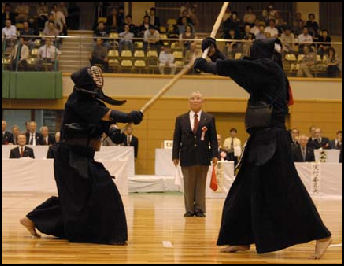
Kenjitsu was adapted from samurai training exercises. Like all martial arts, it was practiced by different schools. The earliest influential school, “nenyu”, was founded in 1350 and taught through the 19th century by the Higuchi family.
Kendo developed into an organized sport in the mid 19th century. It declined somewhat in the Meiji period and made a come back as Japan militarized before World War II. Kendo was outlawed for a while after World War II, but now it is making a comeback in Japanese schools were it is viewed as "a means of instilling spiritual discipline in the young."
Only five swordsmen have reached the 10th dan and gained the title of Hanshi, the highest ranking conferred to a kendoka.
Part of Japan’s Fundamental Law of Education that deals with respect for national traditions requires schools to teach martial arts such as judo and kendo in health and physical education classes in middle school. Currently there aren’t enough teachers that can teach martial arts.
Rules of Kendo
Kendo is performed on a polished wood floor between 9 meters and 11 meters square. The starting position for each combatant is 1.5 meters from the center. “The “sword” used in “kendo”, called a “shinai”, is made of 4 long strips of bamboo. It is quite light and designed to avoid serious injuries during practice sessions. “Kendo “practitioners wear protective equipment that covers them from head to hips. Points are scored by striking the opponent’s head, trunk, or wrist, or by jabbing the throat. The first to score two out of three points wins the match.
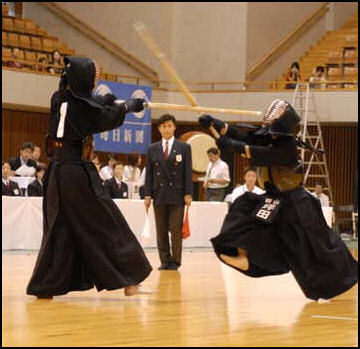
The combatants wear traditional dress that dates back to the samurai era and are barefoot. The outfit includes “hakama” (loose trousers), “tare” (an apron, or groin protector), “keikogi” (kendo jacket), “kote” (heavily-padded gloves) and a “do “(breastplate). The “men” (head guard) is made of padded cloth and has a ribbed metal visor. It covers the head, throat and shoulders. Inside the men combatants were a towel wrapped around their head to keep perspiration from dripping in the eyes,
The are eight main targets in competition kendo — the center of the head, the two sides of the head, the throat, the two sides of the upper chest, the two forearms. A point is scored with a strike or thrust to one of these target areas. Competitors alert their opponents they are going to make a strike with a loud shout and blows must be delivered with the upper third of the bamboo sword. Points can not be scored unless the attacker makes a shout.
Three referees judge a match. Although it seem like many blows are landed in a fight only those delivered with the proper style, footwork, posture and follow through are scored as points. As is true with fencing it often looks like a lot of blows by opponents are delivered at the same time. At least two of the three referees have to agree for a point to be scored. Points are recognized with the raising of a red or white flag, with each flag corresponding with one of the combatants.
Mental and Spiritual Side of Kendo
As is true with other martial arts, inner calm and mental discipline are regarded as key elements of kendo. One of its main goals, an instructor said, is to teach people "to be single-minded without even the smallest trace of doubt or distraction."

One kendo instructor told the Korean Times, "Before combat, the swordsman should be perfectly calm with no expression on his face. He does not openly defy the enemy. He does not stare at his opponent wide-eyed or try to intimidate him with feints. He does not come forward with little steps as if crossing a single-plank bridge, but he walks as if on a wide road with a perfectly normal posture."
There isn’t the emphasis on grading and ranking that there is in other martial arts. . Sometimes the color of keikogi denotes rank the same way belts do in karate and judo. A kendo professor at the Imperial Palace told National Geographic, "We're not teaching these young men a sport, but a way of living, so they can withstand adversity."
In Japan, kendo is widely associated with the three Ks: “kowai” (scary), “kusai” (stinky, the sweat-drenched gloves are particularly stinky) and “kitanai” (dirty). Tough teachers often drill their students for hours without a break.
Japanese Sword Martial Arts
Japanese sword martial arts include “iaido” (the art of drawing a real sword); “naginata” (using a weapon similar to a halberd); and “nitoryu (using two swords) “. There are others.
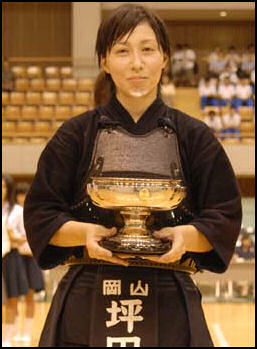
“Iaido” (pronounced ee-eye-doh) is a 500-year-old Japanese martial art performed with swords and is rooted in Zen. In its modern form it is is usually practiced alone and has more in common with tai chi than the fight scenes from a martial arts movie. Practitioners wear a loose kimono-like garment and begin practice sessions with a bow towards a shrine and end it by placing their sword slowly back in the scabbard. Each maneuver is a kind of response to what a potential enemy might do. The sword that is used is sharp enough to severe a limb.
The “naginata” is a long-handled sword-like weapon, measuring 210 centimeters with the handle taking up 170 centimeters of its length. It is regarded as Japan’s oldest weapon. The wielding of this weapon is still practiced today as a martial art, mostly be women, in accordance with Yoshin-ryu Naginata-jitsu (See Below).
“Jigen-ryu” is a school of swordsmanship founded in the late 16th century in Kagoshima Prefecture which places supreme importance on the first sword strike — making powerful and quick initial blow to defeat an opponent. Practitioners of this school train by repeatedly striking a wooden pole with a staff. In the Edo period, jigen-ryiu fighters were encouraged to strike the pole 3,000 times in the morning training sessions and 8,000 times in the afternoon. To make a proper strike practitioners start six meters from the pole, and then approach the pole with a raise s sword, striking it with a downward diagonal thrust, accompanied by a loud, shrieking “Ei!”
Yoshin-ryu
Yoshin-ryu is an esoteric martial art using a naginata (See Above) practiced by women within the confines of wearing a kimono. It is still practiced today by women in accordance with Yoshin-ryu Naginata-jitsu, one of Japan’s oldest schools of marital arts, founded by Akiyama Shirohyoe in the 16th century. In the old days it was taught maid-in-waiting in castles as a means of defending themselves.
The Yoshin-ryu Naginata-jitsu schools uses a variety of weapons, including swords and sticks. Practitioners are taught to be prepared for attack from all directions and move gracefully as the branches of a willow tree and believe a tactical defeat can be used to defeat an enemy. One aphorism from the school goes: “Allow an opponent to cut one’s flesh, but break his bones.”
There are about 80 recognized naginata techniques. The naginata is designed for fighting at a distance but it can also be used at close range with weapons being whirled about vertically and horizontally with surprising speed. Practitioners of naginata use centrifugal force and leverage to get the most out of their weapon’s reach. Killing can be done by stabbing or cutting with the edge of a blade. Women using traditional methods wear long-sleeve kimonos, white tabi socks and hair bands. The sashes and hair bands have traditionally not been hemmed so they can be torn easily and used as bandages if necessary.
Samurai Martial Arts
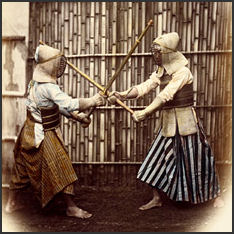
19th century sword training Kobudo, the martial arts of samurai, was a precursor of kendo, judo and other martial arts practiced today. Beginning as a mix of different combat skills, it developed through the mid-Muromachi period (1336-1573) and the Edo period (1603-1867) and branched into different schools of discipline. Of the 1,000 or so schools that existed at the end of the Edo period about 500 are still practiced in some form today.
The Imaeda school is one of the most distinguished kobudo schools of swordsmanship still practiced today. Members of this school, regarded as one of the toughest, train using real swords (not wooden staffs) and heavy armor. The philosophy taught by the school is steeped in Zen and is very esoteric and hard to understand. Swordsmen traditionally cleaned the blood off their sword after making a fatal blood, before sheathing it, with their thumb and index finger.
Imaeda school techniques include “Inchuken”, a technique for fighting in the dark, in which a swordsman moves forward with his sword half unsheathed with the point of the sheath forward to probe for one’s opponent and “nido”, in which a swordsman slices through a roll of two wet tatami mats in a single stroke. Cutting through two wet tatami mat takes about the same strength as cutting through a human torso. Another effective night fighting technique is drawing the sword out in a single motion when the sheath point touches an opponent and cutting the opponent down before he has time to react.
Each Imeada move is accompanied by a difficult-to grasp philosophical theory. “Tsuriashi” is a technique in which a swordsman raises one of his feet to move swiftly after cutting down an opponent. “Shumoko” is a move in which a swordsman overruns a mark and stumbles. Swordsman are taught to cut up from below to intimidate an opponent and not miss any vital organs.
The samurai sword-fighting group Kamui were the “Crazy 88s” in the Quentin Tarantino film “Kill Bill”. They have performed on stage with audience participation.
Shotitsu kenri katachi is a method samurai swordfighting in attacker were taught finish off their opponents with a sword thrust to the groin.
Japanese Archery
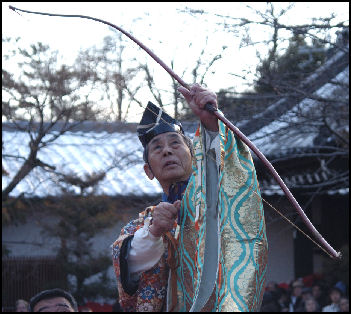
Japanese-style archery has been practiced at least as far back as the A.D. 6th century and over the centuries it has been closely associated with Zen Buddhism. Today, traditional archers use seven-foot bows and wear a costumes that includes a black sash with no shirt underneath, a long skirt-like pair of pants, deerskin chaps and a funny hat. Many traditional archery competition are held on horseback at Zen Buddhist temples.
The 17th century archer, Wada Daihachi, once shot 8,133 arrows down the 384 foot Royal Hall during a 24 hour period (an average of five shots a minute). In the 17th century Japanese archers used 8 foot longbow, considered the longest longbow in history. In the old days, in some competitions, archers who missed their mark were obliged to take their own life.
Yabusame
“Yabusame” (mounted archery) is practiced by skilled horsemen who gallop at full speed and, without stopping, shoot their arrows at three small wood and clay targets arranged along the run. The archers shoots again and again over a 150 meter to 350 meter course, sometimes firing while the horses are galloping at speeds of 65 kilometers per hour.
“Yabusame” originated during the Kamakura period (1185- 1333). It is adapted from samurai training exercises. It is performed at Shimogamo Shrine temple in Kyoto, the Tsurugaoka Hachimangu Shrine in Kamakura and on a beach at Zushi, city south of Tokyo in Kanagawa Prefecture, and a couple other places in Japan. The first competition in Zushi was held in 1199.
In Zushi, the riders gallop down a stretch a beach with banners marking the binning and end of the course before thousands of onlookers. The event’s equivalent of tennis ball boys run around in bright robes and black hats collecting and arrows and pieces of the targets shattered by arrows. The event is organized by the Japan Equestrian Archery Association and the 800-year-old Takeda school of Horseback Archery.
The wooden and clay targets are about the size of an opponents chest and are supported on poles or scaffolding about 2.1 meters off the ground. There are three targets are spaced along the course so that archers have just enough time to raise their bows, load and shoot — three times — all while spurring their horses.
Yabausame is more of an art than a sport. Riders wear deerskin chaps and feudal shooting gear and ride on decorated mount., The competition, if there is one, is based more on how the archer looks when shooting than how many targets he hits.
The bow is taller than a person and looks unbalanced and lopsided. There are no sights or stabilizers like those found on Olympic bows. The arrows have dull, tulip-shaped points that cause the target to explode apart if struck just right. More often than not the archer misses and the arow strike the canvas in back of the target.
See Festivals.
Kyudo
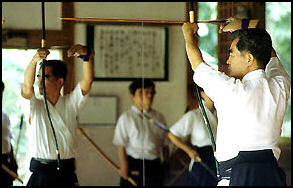
“Kyudo” is traditional archery with longbows. Still performed at the Imperial Palace, it is practiced by men who wear long black skirts and shoot in a “shajo”, or shooting hall, at a target 28 meters away. The best kyudo bows are seven feet long and made with 30-year-old bamboo by master bow makers from families who have been involved in the craft for more than 20 generations. Often archers shoot just two arrows and sometimes have to wait hours to shoot. Maintaining concentration for the moment of truth is an essential elements of the sport.
“Kyudo “ developed during Japan’s feudal period as a fighting art. With the founding of the Japan Kyudo Federation, in 1949, the discipline made a new start as a sport. In a contest, each competitor usually shoots arrows at a target 28 or 60 meters away. The bow, which is about 2.21 meters long, is made of wood and bamboo glued together. As in other forms of archery, the competitor who hits the target with the greatest number of arrows wins the match. The difference between Western archery and “kyudo “is that the latter emphasizes the importance of form. In some contests, the competitor’s form is taken into account. [Source: Web-Japan, Ministry of Foreign Affairs, Japan]
Describing archery practice at the Imperial Palace, Robert Poole wrote in National Geographic, the students "went through an elaborate ritual of preparation, completely focused on the process, as in a trance. Rain soaked the clipped green lawn of the “yamichi”, or arrow path, before them, which led to a whitewashed hut where three targets hung. Each of the archers took his turn, shooting arrows one after another,"
Kyudo is influenced by Zen. The aim of the archer is to become one with the bow, arrow and target and in turn the universe. Sometimes archers are taught to focus their attention and discipline their minds by concentrating on shooting at themselves while aiming ta the target. Tsugihiro Osaki, a master archer at the Imperial Palace, told National Geographic, "You need tranquility to do this, so that you can call on the inner force that makes the arrows fly." His advise is: "Don't aim to hit the target in kyudo. You get the posture right. You get the steps right. Just let the arrow take its course.”
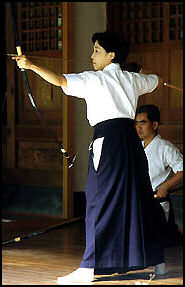
Osaki also said, " "we learn archery for concentration. It builds confidence, a kind of mental awareness. We try to prevent things from happening. It’s easier to anticipate trouble if you have sharpened your mental facilities.”
An Australian who took up the sport told the Daily Yomiuri, “Kyudo is not just a matter of hitting the target. People say the end justifies the means, but this completely opposite in kyudo. The process is more important. I find it the most interesting thing in kyudo, but at the same time, it’s the most difficult part.”
WWII Spy School Taught Ninjutsu Skills
In June 2012, the Yomiuri Shimbun reported: “Training in ninjutsu, or ninja combat techniques and spycraft, was part of the curriculum at the Rikugun Nakano Gakko, a secret training school for military intelligence operatives run by the Imperial Japanese Army during World War II, according to recently discovered documents. The revelation was found in reports to the war minister on the school's inaugural graduating class. [Source: Yomiuri Shimbun, June 21, 2012]
Besides ninjutsu training, students were educated in more conventional intelligence and sabotage techniques, such as bomb-making and photography. The school was believed to have been established to train soldiers to serve behind enemy lines. The reports indicate that a predecessor counterintelligence institute was established in Kudan, Tokyo, in April 1938. [Ibid]
While the curriculum called for 1,361 credits to be earned, graduates actually completed 1,290 credits. First-semester classes included military science--including foreign militaries, topography and weapons--three foreign languages (Russian, English and Chinese), swordsmanship, judo, photography, intelligence techniques and ninjutsu. The reports do not describe the specific ninjutsu skills that were taught, although they do show that the initial plan to teach one ninjutsu credit was expanded to three. In the second semester, bacteriology, pharmacology, practical bomb techniques and other topics were added. [Ibid]
Image Sources: 1) Ray Kinnane 3) 4) 5) 6) All Japan Kendo Federation 7) Visualizing Culture, MIT Education 8), 9) Japan-Photo.de
Text Sources: New York Times, Washington Post, Los Angeles Times, Daily Yomiuri, Times of London, Japan National Tourist Organization (JNTO), National Geographic, The New Yorker, Time, Newsweek, Reuters, AP, Lonely Planet Guides, Compton’s Encyclopedia and various books and other publications.
Last updated January 2013
